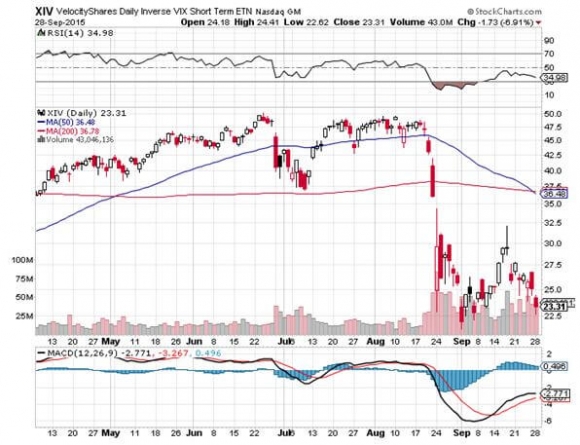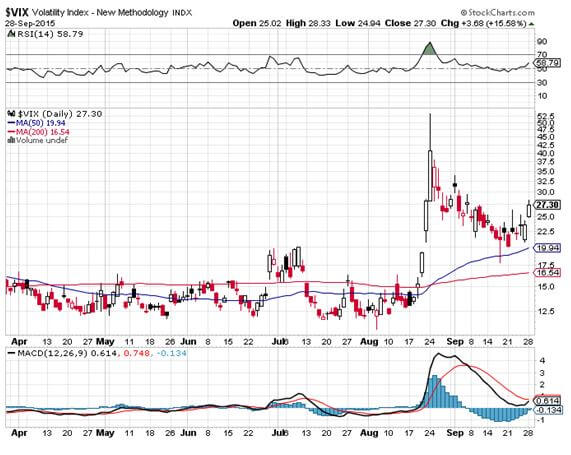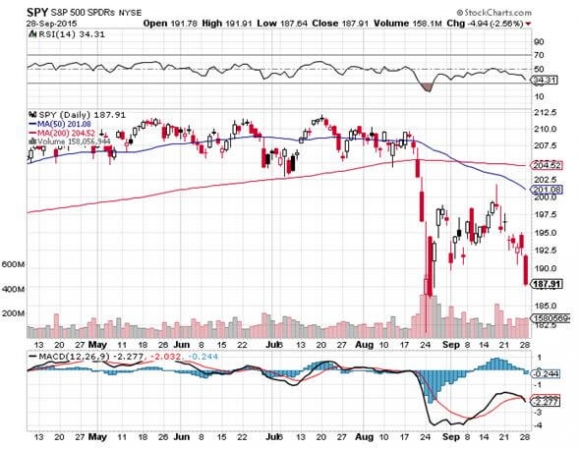Loading Up on the (XIV)
Excuse me, but am I missing something here?
Has my advanced age obscured my vision, clouded my judgment, and left me discombobulated?
These are the thoughts that kept coming to mind when I looked at the action in the Velocity Shares Daily Inverse VIX Short Term ETN (XIV) on Monday.
At the absolute bottom of the August 24 flash crash, the Volatility Index (VIX) spiked up to $53. The (XIV) cratered to $22.20, or down some 53.75% from its week earlier level.
So far, so good.
During Monday?s market meltdown, the (VIX) traded up only to $28.33, but the (XIV) nearly revisited that August $22.20 low once more.
Isn?t this supposed to be mathematically impossible?
Something is out of whack here.
Either someone has invented a new math when I wasn?t looking, or these securities are mispriced.
Either the (VIX) is overbought, or the (XIV) is oversold. Given the humongous 50 point dive in the S&P 500 on Monday, I vote for the latter.
Whenever I see something artificially undervalued, I am inclined to don my ?BUY? hat. So I am committing 10% of my portfolio to a new position in the (XIV).
I have to admit that I am somewhat prejudiced when it comes to the (XIV), as I have had three profitable round trips with this baby in September.
It?s like the hot new girlfriend that falls in love with you, then dumps you?.three times in one week.
Besides, what else is there to buy?
I am still expecting a major league puke out in stocks in October, if not a full fledged crash. So, it?s way to early to start picking up bull call options spreads in single names, even the best ones.
So that leaves me with trading bullish and bearish vertical call and put options spreads in the S&P 500, which with this elevated volatility, I am pursuing with a vengeance on a daily basis.
And then there?s the (XIV).
Trading volatility can be a tricky animal. But if you get it right, you can make a fortune. This is why about half the Chicago traders still in business make a full time living trading just the (VIX).
You can pay all the way up to $24 for the (XIV) Exchange Traded Note and it still makes sense.
THIS THING WAS TRADING AT AN EYE POPPING $32.50 ONLY 10 DAYS AGO!
I?m betting that sometime in my life, the Volatility Index (VIX) will trade below today?s $28.33 high. In fact, I expect it to trade back to the mid teens within the next month.
If I am right, this position should increase in value by 50% when that happens.
If I am wrong, and the (VIX) trades higher than $53 in October, it will be only by a couple of points and for a couple of days. Like the hydrogen-7 isotope, (VIX) spikes tend to have a very short half-life (21 X 10 -24 seconds).
To make it easy for you, I am avoiding the 2X and 3X short volatility ETN?s out there, as well as the options market. That way, you don?t have to fight against the clock, and keep your partner awake all night tossing and turning.
The natural state is for volatility to fall over time, which it spends 90% of every year doing.
The current 30-day historic volatility for the S&P 500 is a hefty 27%. But a month ago, it was 18.51%, and at one point in the past twelve months, it fell as low as 3.03%.
So we are definitely at the very high end of the range. In other words, we are in fertile shorting territory.
The CBOE Volatility Index (VIX) is a measure of the implied volatility of the S&P 500 stock index.
You may know of this from the many clueless talking heads on TV, beginners, and newbies who call this the ?Fear Index?.
For those of you who have a PhD in higher mathematics from MIT, the (VIX) is simply a weighted blend of prices for a range of options on the S&P 500 index.
The formula uses a kernel-smoothed estimator that takes as inputs the current market prices for all out-of-the-money calls and puts for the front month and second month expiration's.
The (VIX) is the square root of the par variance swap rate for a 30 day term initiated today.
To get into the pricing of the individual (VIX) options, please go look up your handy dandy and ever useful Black-Scholes equation. You will recall that this is the equation that derives from the Brownian motion of heat transference in metals.
Got all that?
For the rest of you who do not possess a PhD in higher mathematics from MIT, and maybe scored a 450 on your math SAT test, or who don?t know what an SAT test is, this is what you need to know.
When the market goes up, the (VIX) goes down. When the market goes down, the (VIX) goes up.
End of story. Class dismissed.
The (VIX) is expressed in terms of the annualized movement in the S&P 500, which on Monday closed at 1,881.77. So a (VIX) of $28 means that the market expects the index to move 8.09%, or 152.17 S&P 500 points, over the next 30 days.
To oblige, the big cap index has to therefore stay with a 1,729.60 ? 2,033.94 range.
You get this by calculating $28/3.46 = 8.09%, where the square root of 12 months is 3.46.
The volatility index doesn?t really care which way the stock index moves. If the S&P 500 moves less than the projected 8.09% over the allotted time, you are guaranteed a profit on your long (XIV) positions.
I?m more than happy to make that bet.
I am going into this detail because I always get a million questions whenever I raise this subject with volatility-deprived investors.
After spending years stuck in in the $12-$15 range, it was nothing less than mind blowing to see it spike up to $53 August.
For a detailed description of this 1X short volatility ETN please click the link for the issuer?s website at http://www.velocitysharesetns.com/xiv.
GOOD LUCK AND GOOD TRADING!






